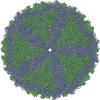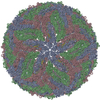+ Open data
Open data
- Basic information
Basic information
| Entry | Database: PDB / ID: 7mh2 | ||||||
|---|---|---|---|---|---|---|---|
| Title | T4GALA Engineered Protein Nanocage | ||||||
 Components Components | T4GALA Engineered Protein Nanocage | ||||||
 Keywords Keywords |  VIRUS LIKE PARTICLE / VIRUS LIKE PARTICLE /  Encapsulin / Encapsulin /  Nanocage / Nanocage /  Nanocompartment Nanocompartment | ||||||
| Function / homology | Type 1 encapsulin shell protein / Encapsulating protein for peroxidase /  encapsulin nanocompartment / iron ion transport / intracellular iron ion homeostasis / Type 1 encapsulin shell protein encapsulin nanocompartment / iron ion transport / intracellular iron ion homeostasis / Type 1 encapsulin shell protein Function and homology information Function and homology information | ||||||
| Biological species |  | ||||||
| Method |  ELECTRON MICROSCOPY / ELECTRON MICROSCOPY /  single particle reconstruction / single particle reconstruction /  cryo EM / Resolution: 3.57 Å cryo EM / Resolution: 3.57 Å | ||||||
 Authors Authors | Andreas, M.P. / Jones, J.A. / Cristie-David, A.S. / Giessen, T.W. | ||||||
| Funding support |  United States, 1items United States, 1items
| ||||||
 Citation Citation |  Journal: Angew Chem Int Ed Engl / Year: 2021 Journal: Angew Chem Int Ed Engl / Year: 2021Title: Triggered Reversible Disassembly of an Engineered Protein Nanocage*. Authors: Jesse A Jones / Ajitha S Cristie-David / Michael P Andreas / Tobias W Giessen /  Abstract: Protein nanocages play crucial roles in sub-cellular compartmentalization and spatial control in all domains of life and have been used as biomolecular tools for applications in biocatalysis, drug ...Protein nanocages play crucial roles in sub-cellular compartmentalization and spatial control in all domains of life and have been used as biomolecular tools for applications in biocatalysis, drug delivery, and bionanotechnology. The ability to control their assembly state under physiological conditions would further expand their practical utility. To gain such control, we introduced a peptide capable of triggering conformational change at a key structural position in the largest known encapsulin nanocompartment. We report the structure of the resulting engineered nanocage and demonstrate its ability to disassemble and reassemble on demand under physiological conditions. We demonstrate its capacity for in vivo encapsulation of proteins of choice while also demonstrating in vitro cargo loading capabilities. Our results represent a functionally robust addition to the nanocage toolbox and a novel approach for controlling protein nanocage disassembly and reassembly under mild conditions. | ||||||
| History |
|
- Structure visualization
Structure visualization
| Movie |
 Movie viewer Movie viewer |
|---|---|
| Structure viewer | Molecule:  Molmil Molmil Jmol/JSmol Jmol/JSmol |
- Downloads & links
Downloads & links
- Download
Download
| PDBx/mmCIF format |  7mh2.cif.gz 7mh2.cif.gz | 206 KB | Display |  PDBx/mmCIF format PDBx/mmCIF format |
|---|---|---|---|---|
| PDB format |  pdb7mh2.ent.gz pdb7mh2.ent.gz | 167.1 KB | Display |  PDB format PDB format |
| PDBx/mmJSON format |  7mh2.json.gz 7mh2.json.gz | Tree view |  PDBx/mmJSON format PDBx/mmJSON format | |
| Others |  Other downloads Other downloads |
-Validation report
| Arichive directory |  https://data.pdbj.org/pub/pdb/validation_reports/mh/7mh2 https://data.pdbj.org/pub/pdb/validation_reports/mh/7mh2 ftp://data.pdbj.org/pub/pdb/validation_reports/mh/7mh2 ftp://data.pdbj.org/pub/pdb/validation_reports/mh/7mh2 | HTTPS FTP |
|---|
-Related structure data
| Related structure data |  23834MC M: map data used to model this data C: citing same article ( |
|---|---|
| Similar structure data |
- Links
Links
- Assembly
Assembly
| Deposited unit | 
|
|---|---|
| 1 | x 60
|
| 2 |
|
| 3 | x 5
|
| 4 | x 6
|
| 5 | 
|
| Symmetry | Point symmetry: (Schoenflies symbol : I (icosahedral : I (icosahedral )) )) |
- Components
Components
| #1: Protein | Mass: 35290.652 Da / Num. of mol.: 4 Source method: isolated from a genetically manipulated source Details: Amino Acids 58-83: synthetic GALA peptide insertion; Amino Acids 305-310: Linker; Amino Acids 311-316: Affinity Tag Source: (gene. exp.)  Gene: QY95_01592 / Production host:   Escherichia coli BL21(DE3) (bacteria) / References: UniProt: A0A0F5HPP7 Escherichia coli BL21(DE3) (bacteria) / References: UniProt: A0A0F5HPP7 |
|---|
-Experimental details
-Experiment
| Experiment | Method:  ELECTRON MICROSCOPY ELECTRON MICROSCOPY |
|---|---|
| EM experiment | Aggregation state: PARTICLE / 3D reconstruction method:  single particle reconstruction single particle reconstruction |
- Sample preparation
Sample preparation
| Component | Name: T4GALA Engineered Protein Nanocage / Type: COMPLEX / Entity ID: all / Source: RECOMBINANT | |||||||||||||||
|---|---|---|---|---|---|---|---|---|---|---|---|---|---|---|---|---|
| Source (natural) | Organism:  | |||||||||||||||
| Source (recombinant) | Organism:   Escherichia coli BL21(DE3) (bacteria) Escherichia coli BL21(DE3) (bacteria) | |||||||||||||||
| Buffer solution | pH: 7.5 | |||||||||||||||
| Buffer component |
| |||||||||||||||
| Specimen | Conc.: 0.76 mg/ml / Embedding applied: NO / Shadowing applied: NO / Staining applied : NO / Vitrification applied : NO / Vitrification applied : YES : YES | |||||||||||||||
| Specimen support | Details: 60 seconds, 5 mA / Grid material: COPPER / Grid mesh size: 200 divisions/in. / Grid type: Quantifoil R1.2/1.3 | |||||||||||||||
Vitrification | Instrument: FEI VITROBOT MARK IV / Cryogen name: ETHANE / Humidity: 100 % / Chamber temperature: 295 K Details: Blot force: 20 Blot time: 4 seconds Wait time: 0 seconds |
- Electron microscopy imaging
Electron microscopy imaging
| Microscopy | Model: TFS GLACIOS |
|---|---|
| Electron gun | Electron source : :  FIELD EMISSION GUN / Accelerating voltage: 200 kV / Illumination mode: FLOOD BEAM FIELD EMISSION GUN / Accelerating voltage: 200 kV / Illumination mode: FLOOD BEAM |
| Electron lens | Mode: BRIGHT FIELD Bright-field microscopy / Nominal magnification: 45000 X / Nominal defocus max: -1800 nm / Nominal defocus min: -1300 nm / Cs Bright-field microscopy / Nominal magnification: 45000 X / Nominal defocus max: -1800 nm / Nominal defocus min: -1300 nm / Cs : 2.7 mm / C2 aperture diameter: 100 µm : 2.7 mm / C2 aperture diameter: 100 µm |
| Specimen holder | Cryogen: NITROGEN |
| Image recording | Average exposure time: 8 sec. / Electron dose: 62 e/Å2 / Detector mode: COUNTING / Film or detector model: GATAN K2 SUMMIT (4k x 4k) / Num. of grids imaged: 1 / Num. of real images: 1259 |
| Image scans | Movie frames/image: 40 |
- Processing
Processing
| EM software |
| |||||||||||||||||||||||||||||||||||||||||||||||||||||||
|---|---|---|---|---|---|---|---|---|---|---|---|---|---|---|---|---|---|---|---|---|---|---|---|---|---|---|---|---|---|---|---|---|---|---|---|---|---|---|---|---|---|---|---|---|---|---|---|---|---|---|---|---|---|---|---|---|
CTF correction | Type: PHASE FLIPPING AND AMPLITUDE CORRECTION | |||||||||||||||||||||||||||||||||||||||||||||||||||||||
| Symmetry | Point symmetry : I (icosahedral : I (icosahedral ) ) | |||||||||||||||||||||||||||||||||||||||||||||||||||||||
3D reconstruction | Resolution: 3.57 Å / Resolution method: FSC 0.143 CUT-OFF / Num. of particles: 6707 / Symmetry type: POINT | |||||||||||||||||||||||||||||||||||||||||||||||||||||||
| Atomic model building | B value: 81.22 / Protocol: FLEXIBLE FIT / Space: REAL / Target criteria: Correlation Coefficient Details: Model was initially docked in Chimera using Fit to Map command. Chains were manually refined in Coot with rigid body refinement, chain refinement, and iterative real space refinements. ASU ...Details: Model was initially docked in Chimera using Fit to Map command. Chains were manually refined in Coot with rigid body refinement, chain refinement, and iterative real space refinements. ASU was then refined using phenix.real_space_refine with default parameters. NCS operators were applied and refined again with NCS contstraints, global minimization, and ADP refinement. | |||||||||||||||||||||||||||||||||||||||||||||||||||||||
| Atomic model building | PDB-ID: 6NJ8 Accession code: 6NJ8 / Source name: PDB / Type: experimental model |
 Movie
Movie Controller
Controller











 PDBj
PDBj

